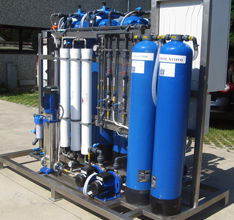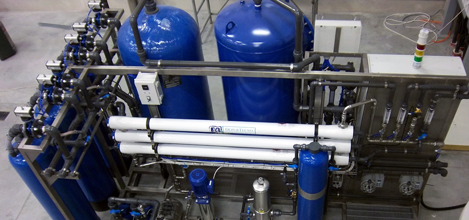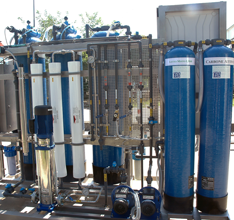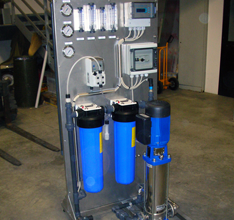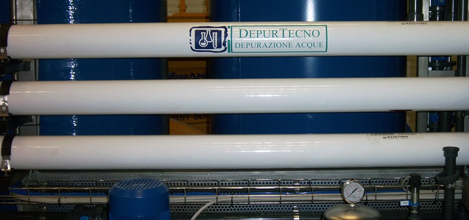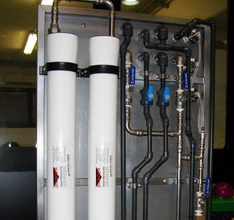OTHER PLANTS
REVERSE OSMOSIS
Reverse osmosis systems are preferably used when there is a continuous demand of pure water, minimum encumbrance and low costs for assistance and maintenance. On the ground of water’s quality and pure water’s demands, an individual pre-treatment and post-treatment often turn out necessary. For this reverse osmosis system can be integrated with suitable equipment for the pre-treatment, like softening, filtration and dosing systems. For the post-treatment it can be installs filters with mixed bed ionexchange resins. The process is based on the semipermeable membrane use which let water pass keeping the 99-99,7% of the ions contained in the same one. The osmosis is a natural phenomenon by which between two solutions to different concentration separated from a semipermeable membrane, the water tends to pass from the solution more diluted to that concentrated more. Reverse osmosis, on the contrary, is a process of separation of the bodies strangers in the water by means of semipermeable membranes, that allow the passage of the water, but with hold the melted salts, colloids and the bacteria. This procedure is obtained applying to the concentrated solution a greater pressure than the osmotic pressure that reverses the flow through the membrane obtaining the separation between the dissolved salts and the water. Unlike other types of filtrations, where all the water crosses the filter carrying it in short to the saturation and/or replacement of the cartridges, in the reverse osmosis there is a “tangential” filtration; in this filtration there are two flows in escape from the system, the “concentrated”, which contains impurity that are rejected and don’t pass through the membrane, and the “permeate” which is the result of the treatment. The concentrated is sent to the wastewater in complete observance of the norms in matter of wastewater concurring therefore a washing in continuous, that guarantees the exercise of the system for along time before proceeding to a true washing and just of membranes. The wastewater can be recovered in other workings, where isn’t demanded a water’s quality with a saltness particularly low. The described process over demands only the necessary electric power for the feeding of the pumps of high pressure.
| SYSTEM FOR SMALL USERS | |||
|
Model Production l/h Recovery max Pressure min/max Membranes number Temperature water Electrical feeding Electrical absorption Working pressure Dimensions (H*L*W) Weight c.a. kg |
OI – 4 40 60% 2/5 1 10 ÷ 30°C 220V 50Hz 275 W 9 bar 38x70x32 cm 13 |
OI – 8 80 60% 2/5 1 10 ÷ 30°C 220V 50Hz 275 W 9 bar 38x70x32 cm 15 |
OI – 16 160 60% 2/5 2 10 ÷ 30°C 220V 50Hz 275 W 9 bar 38x70x32 cm 18 |
The systems come realized either in series version or based on the requirements of the customer. They are realized by modular elements pre-assembled and pre-tested on structure in stainless steel INOX AISI 304 (on the skid there are placed electric panel, pneumatic panel, supply pump system, flow meters of control capacities, filters, electric-pneumatic control group). The automation happens through pneumatic valves. The control of phases of working is carried out through electronic standard programmer or controller by logic to programme (PLC).










